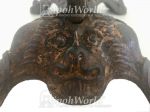We've tried to ensure the information displayed here is as accurate as possible. Should there be any inaccuracies, we would be grateful if you could let us know at info@ipohworld.org . All images and content are copyright.
(Please click on the thumbnail for a bigger image.)
An Antique Cast Iron Cycle Stand




Probably unique in Malaysia, this is a rare bicycle stand marked with its Patent registered number and the name Millennium . These details provide the information that it was patented 20 October 1899 under the name of "Lake and Elliot" and manufactured to mark the millennium (1900) at the end of the year. The stand has a detailed cast iron base in the form of a stylised creature with a dog’s head (probably the British Bulldog) at each end, four clawed feet and is embossed "Millennium". The upright frame holds the embossed number RD 347707.
These were used for maintenance in the workshop and to display bicycles in shops or exhibitions. They would hold the cycle off the floor with the pedal hub resting on the support, with the front wheel between the two prongs and the main frame clamped in the mount. Our example is original and in good working order with some of the original black and gold paint showing. It stands 21" tall x 8.5" wide at base and overall 15" front to back.
An almost identical version of this patent is embossed with the name “Willbro Nottingham”. This was marketed by Willmott’s of Norwich at Willmott’s Stores Limited, Willbro House, 45-52 Prince of Wales Road, Norwich, England. It is not known whether it was made under licence from the original patentee. It is much more common than the Millenium.
Jor Mason describes the Millbro House store:
“Millbro House had a pneumatic tube in which your payment was placed in a container. It was sucked away to a mysterious place you never saw, to return a few moments later with your change and receipt. They sold electrical goods like irons and toasters and stocked Alan Sugar’s first Amstrad product, a tape deck. They sold bicycles, model railways (of which they had the best selection in the city, better even than Pilch’s) and on the first floor, records. These were vinyl 45 rpm pop songs and 33 rpm LPs which were mostly classical. The idea of groups producing LPs – albums – took of with the Beatles. You could go into a booth and listen to tracks of an LP before buying. Willmotts was a relative newcomer to the Norwich shopping firmament, only having begun in 1910.”
Thus a stand marked Willbro will date from after 1910.